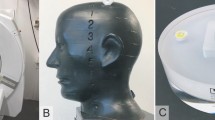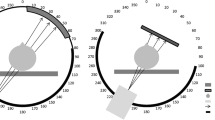Abstract
Introduction
The purpose of this experimental study was to investigate the effect of tube tension reduction on image contrast and image quality in pediatric temporal bone computed tomography (CT).
Methods
Seven lamb heads with infant-equivalent sizes were scanned repeatedly, using four tube tensions from 140 to 80 kV while the CT-Dose Index (CTDI) was held constant. Scanning was repeated with four CTDI values from 30 to 3 mGy. Image contrast was calculated for the middle ear as the Hounsfield unit (HU) difference between bone and air and for the inner ear as the HU difference between bone and fluid. The influence of tube tension on high-contrast detail delineation was evaluated using a phantom. The subjective image quality of eight middle and inner ear structures was assessed using a 4-point scale (scores 1–2 = insufficient; scores 3–4 = sufficient).
Results
Middle and inner ear contrast showed a near linear increase with tube tension reduction (r = −0.94/−0.88) and was highest at 80 kV. Tube tension had no influence on spatial resolution. Subjective image quality analysis showed significantly better scoring at lower tube tensions, with highest image quality at 80 kV. However, image quality improvement was most relevant for low-dose scans.
Conclusions
Image contrast in the temporal bone is significantly higher at low tube tensions, leading to a better subjective image quality. Highest contrast and best quality were found at 80 kV. This image quality improvement might be utilized to further reduce the radiation dose in pediatric low-dose CT protocols.








Similar content being viewed by others
References
Fazel R, Krumholz HM, Wang Y, Ross JS, Chen J, Ting HH, Shah ND, Nasir K, Einstein AJ, Nallamothu BK (2009) Exposure to low-dose ionizing radiation from medical imaging procedures. N Engl J Med 361(9):849–857. doi:10.1056/NEJMoa0901249
Brenner DJ, Hall EJ (2007) Computed tomography—an increasing source of radiation exposure. N Engl J Med 357(22):2277–2284. doi:10.1056/NEJMra072149
Linet MS, Kim KP, Rajaraman P (2009) Children’s exposure to diagnostic medical radiation and cancer risk: epidemiologic and dosimetric considerations. Pediatr Radiol 39(Suppl 1):S4–S26. doi:10.1007/s00247-008-1026-3
Brenner D, Elliston C, Hall E, Berdon W (2001) Estimated risks of radiation-induced fatal cancer from pediatric CT. AJR Am J Roentgenol 176(2):289–296
Huda W, Lieberman KA, Chang J, Roskopf ML (2004) Patient size and X-ray technique factors in head computed tomography examinations. II. Image quality. Med Phys 31(3):595–601
Khursheed A, Hillier MC, Shrimpton PC, Wall BF (2002) Influence of patient age on normalized effective doses calculated for CT examinations. Br J Radiol 75(898):819–830
Bettman R, Beek E, Van Olphen A, Zonneveld F, Huizing E (2004) MRI versus CT in assessment of cochlear patency in cochlear implant candidates. Acta Otolaryngol 124(5):577–581
Robson CD (2006) Congenital hearing impairment. Pediatr Radiol 36(4):309–324. doi:10.1007/s00247-005-0042-9
Vazquez E, Castellote A, Piqueras J, Mauleon S, Creixell S, Pumarola F, Figueras C, Carreno JC, Lucaya J (2003) Imaging of complications of acute mastoiditis in children. Radiographics 23(2):359–372
Radiation risks and pediatric computed tomography (CT): a guide for health care providers National Cancer Institute Website. http://www.cancer.gov/cancertopics/causes/radiation/radiation-risks-pediatric-CT. Accessed 13th of July 2011
Goske MJ, Applegate KE, Boylan J, Butler PF, Callahan MJ, Coley BD, Farley S, Frush DP, Hernanz-Schulman M, Jaramillo D, Johnson ND, Kaste SC, Morrison G, Strauss KJ, Tuggle N (2008) The Image Gently campaign: working together to change practice. AJR Am J Roentgenol 190(2):273–274. doi:10.2214/AJR.07.3526
Vock P (2005) CT dose reduction in children. Eur Radiol 15(11):2330–2340. doi:10.1007/s00330-005-2856-0
Szucs-Farkas Z, Semadeni M, Bensler S, Patak MA, von Allmen G, Vock P, Schindera ST (2009) Endoleak detection with CT angiography in an abdominal aortic aneurysm phantom: effect of tube energy, simulated patient size, and physical properties of endoleaks. Radiology 251(2):590–598. doi:10.1148/radiol.2512081687
Wintermark M, Maeder P, Verdun FR, Thiran JP, Valley JF, Schnyder P, Meuli R (2000) Using 80 kVp versus 120 kVp in perfusion CT measurement of regional cerebral blood flow. AJNR Am J Neuroradiol 21(10):1881–1884
Seibel VA, Lavinsky L, De Oliveira JA (2006) Morphometric study of the external and middle ear anatomy in sheep: a possible model for ear experiments. Clin Anat 19(6):503–509. doi:10.1002/ca.20218
Seibel VA, Lavinsky L, Irion K (2006) CT-Scan sheep and human inner ear morphometric comparison. Braz J Otorhinolaryngol 72(3):370–376
Suetens P (2009) Fundamentals of medical imaging, 2nd edn. Cambridge University Press, Cambridge
Walsh C, Dowling A, Meade A, Malone J (2005) Subjective and objective measures of image quality in digital fluoroscopy. Radiat Prot Dosim 117(1–3):34–37. doi:10.1093/rpd/nci708
Miracle AC, Mukherji SK (2009) Conebeam CT of the head and neck, part 2: clinical applications. AJNR Am J Neuroradiol 30(7):1285–1292. doi:10.3174/ajnr.A1654
Huda W, Lieberman KA, Chang J, Roskopf ML (2004) Patient size and x-ray technique factors in head computed tomography examinations. I. Radiation doses. Med Phys 31(3):588–594
Acknowledgments
The authors thank M. Jonczy, N. Paquier, and P. Flach for their participation in the image quality assessment of the high-contrast phantom.
Conflict of interest
We declare that we have no conflict of interest.
Author information
Authors and Affiliations
Corresponding author
Rights and permissions
About this article
Cite this article
Nauer, C.B., Zubler, C., Weisstanner, C. et al. Radiation dose optimization in pediatric temporal bone computed tomography: influence of tube tension on image contrast and image quality. Neuroradiology 54, 247–254 (2012). https://doi.org/10.1007/s00234-011-0961-0
Received:
Accepted:
Published:
Issue Date:
DOI: https://doi.org/10.1007/s00234-011-0961-0




